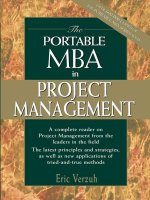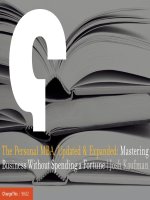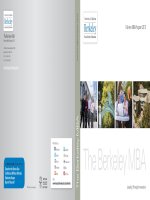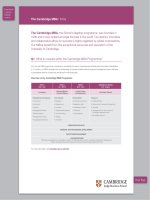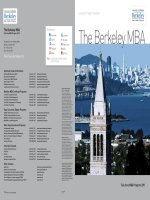The Portable MBA
Bạn đang xem bản rút gọn của tài liệu. Xem và tải ngay bản đầy đủ của tài liệu tại đây (5.4 MB, 381 trang )
P1: OTA/XYZ P2: ABC
ind JWBT260-Eades March 16, 2010 12:45 Printer Name: Hamilton
P1: OTA/XYZ P2: ABC
fm JWBT260-Eades March 16, 2010 12:36 Printer Name: Hamilton
The
Portable
MBA
P1: OTA/XYZ P2: ABC
fm JWBT260-Eades March 16, 2010 12:36 Printer Name: Hamilton
P1: OTA/XYZ P2: ABC
fm JWBT260-Eades March 16, 2010 12:36 Printer Name: Hamilton
The
Portable
MBA
FIFTH EDITION
Edited by
Kenneth M. Eades
Lynn A. Isabella
Timothy M. Laseter
Peter L. Rodriguez
Paul J. Simko
Ian Skurnik
John Wiley & Sons, Inc.
P1: OTA/XYZ P2: ABC
fm JWBT260-Eades March 16, 2010 12:36 Printer Name: Hamilton
This book is printed on acid-free paper.
∞
Copyright
C
2010 by Kenneth M. Eades, Lynn A. Isabella, Timothy M. Laseter, Peter L. Rodriguez, Paul J. Simko,
and Ian Skurnik. All rights reserved.
Published by John Wiley & Sons, Inc., Hoboken, New Jersey.
Published simultaneously in Canada.
No part of this publication may be reproduced, stored in a retrieval system, or transmitted in any form or by any
means, electronic, mechanical, photocopying, recording, scanning, or otherwise, except as permitted under Section
107 or 108 of the 1976 United States Copyright Act, without either the prior written permission of the Publisher, or
authorization through payment of the appropriate per-copy fee to the Copyright Clearance Center, Inc., 222
Rosewood Drive, Danvers, MA 01923, (978) 750-8400, fax (978) 646-8600, or on the web
at www.copyright.com.
Requests
to the Publisher for permission should be addressed to the Permissions Department, John Wiley & Sons,
Inc., 111
River Street, Hoboken, NJ 07030, (201) 748-6011, fax (201) 748-6008, or online at
/>Limit of Liability/Disclaimer of Warranty: While the publisher and author have used their best efforts in preparing
this book, they make no representations or warranties with respect to the accuracy or completeness of the contents
of this book and specifically disclaim any implied warranties of merchantability or fitness for a particular purpose.
No warranty may be created or extended by sales representatives or written sales materials. The advice and
strategies contained herein may not be suitable for your situation. You should consult with a professional where
appropriate. Neither the publisher nor author shall be liable for any loss of profit or any other commercial damages,
including but not limited to special, incidental, consequential, or other damages.
For general information on our other products and services or for technical support, please contact our Customer
Care Department within the United States at (800) 762-2974, outside the United States at (317) 572-3993 or fax
(317) 572-4002.
Wiley also publishes its books in a variety of electronic formats. Some content that appears in print may not be
available in electronic books. For more information about Wiley products, visit our web site at www.wiley.com.
Library of Congress Cataloging-in-Publication Data:
The portable MBA / Kenneth M. Eades, Lynn A. Isabella, Timothy M. Laseter,
Peter L. Rodriguez, Paul J. Simko, and Ian Skurnik. — 5th ed.
p. cm.
ISBN 978-0-470-48129-5 (cloth)
1. Management. 2. Marketing. 3. Accounting. 4. Personnel management.
I. Eades, Kenneth M.
HD31.C6134 2010
658—dc22 2009049299
Printed in the United States of America.
10987654321
P1: OTA/XYZ P2: ABC
fm JWBT260-Eades March 16, 2010 12:36 Printer Name: Hamilton
Contents
List of Downloadable Materials vii
Preface ix
About the Authors xv
Introduction: The MBA Degree Experience 1
1 Accounting Principles 8
2 The Principles of Economics 28
3 Introduction to Business Ethics 47
4 Marketing Management 63
5 Financial Management 83
6 Operations Management 111
7 Managing People 134
8 Supply Chain Management 156
9 Strategy—Defining and Developing Competitive Advantage 169
10 Financial Analysis and Firm Valuation 187
11 Consumer Behavior 216
12 New Product Creation 227
13 Entrepreneurship 243
14 Emerging Markets and Development 259
15 Enterprise Risk Management 277
16 Leading from the Middle 301
17 Managing Teams 314
18 Starting Your New Career with an MBA 332
Index 339
v
P1: OTA/XYZ P2: ABC
fm JWBT260-Eades March 16, 2010 12:36 Printer Name: Hamilton
P1: OTA/XYZ P2: ABC
fm JWBT260-Eades March 16, 2010 12:36 Printer Name: Hamilton
List of Downloadable Materials
Online and in this book:
Downloadable Exhibits 1.1–1.4: PepsiCo Financial Statements and Financial Ratios
Downloadable Exhibit 5.3: Estimate of the Value-Added of Replacing a Standard
Machine with an Upgraded Machine
Downloadable Exhibit 5.4: Hypothetical Example of Value Creation
Downloadable Exhibit 5.5: Hypothetical Example of Value Destruction
Downloadable Exhibit 5.7: Illustration of Value Creation and Destruction: Market-
to-Book Ratios as the Reinvestment Proportion and Return on Capital Spread
Vary
Downloadable Exhibit 5.8: Illustration of Value Creation and Destruction: Market-
to-Book Ratios as the Life of the Project and Its Return on Capital Spread Vary
Downloadable Exhibits 5.9 and 5.10: Net Present Value Calculation of a Bond’s Cash
Flows from the Standpoint of the Issuer
Downloadable Exhibit 10.1: Percentage Change Income Statements
Downloadable Exhibit 10.2: Common-Size Vertical Income Statements
Downloadable Exhibit 10.3: Percentage Change Balance Sheets
Downloadable Exhibit 10.4: Common-Size Vertical Balance Sheets
Downloadable Exhibit 10.5: Percentage Change Statements of Cash Flow
Downloadable Exhibit 10.6: Summary of Other Key Financial Ratios
Downloadable Exhibits 10.8–10.12: Forecasts and Firm Valuation Estimation
vii
P1: OTA/XYZ P2: ABC
fm JWBT260-Eades March 16, 2010 12:36 Printer Name: Hamilton
P1: OTA/XYZ P2: ABC
fm JWBT260-Eades March 16, 2010 12:36 Printer Name: Hamilton
Preface
The first edition of The Portable MBA was published January 1, 1990. Many changes
have occurred across the business landscape over the ensuing two decades, and we have
updated our readers about the more salient events with each new edition of this book.
In fact, much has happened since 2004 when the fourth edition was published, and we
will put those extraordinary events in perspective in the second section of this Preface.
Before discussing the past five years of business history, however, there are a number of
improvements in this revision that you should know about.
The Fifth Edition
Whether you already have a master of business administration (MBA) degree and are
looking for a refresher or you are thinking about entering an MBA program in the near
future, you will find this book to be a highly useful resource. To start with, The Portable
MBA allows you walk the walk of learning the concepts of business. Reading through
these chapters and working through the examples provided is the best way for you to get
a sneak preview of the feature-length production. Many of the chapters include examples
that are available for you to use live on John Wiley & Sons’ web site. Simply go to the web
site (www.wiley.com/go/portablemba5e) and click the example of interest to see how the
numbers were created. Change an assumption for the problem and see how it affects
the final answer. True learning comes from the doing, not the watching, and these live
examples allow you to experience some of the analytical work required of MBA students.
The more you can reinforce concepts by putting them into action, the better you will be
able to use those concepts to improve your decision-making skills and to become a more
effective leader in the world of business.
While you are on the web site, you will have the opportunity to meet the author team
by observing us teach in our classrooms. Our hope is that these videos will serve to give
a personal touch to the words we have written in the chapters that follow. Also, you will
gain an appreciation for the classroom experience for an MBA program. We will have
more to say about the experience of earning an MBA in the next chapter.
As part of our desire to put you in the MBA experience, many of the chapters show how
the materials presented relate to specific courses in top-rated programs. For example,
Chapter 5, Financial Management, presents the content of a core course in corporate
finance, which is part of all MBA programs, albeit under different titles. At the University
of Chicago there are two courses, Introductory Finance and Corporation Finance, that
cover the theory and practice of finance. At Harvard the courses are called Finance I
ix
P1: OTA/XYZ P2: ABC
fm JWBT260-Eades March 16, 2010 12:36 Printer Name: Hamilton
x
Preface
and Finance II. Stanford’s principles course is entitled Managerial Finance, whereas the
University of Virginia’s Darden School offers Financial Management and Policies as the
first course in finance. These same comparisons are provided for accounting, operations,
economics, and so on. This information will help you appreciate how business school
curricula differ and how they are similar.
And finally, we have provided information about career paths after earning an MBA.
Many chapters give a summary of MBA career opportunities to give you a feel for the
type of position an MBA might accept as a first job after graduation. For example, there
are a host of MBA-level positions in the finance industry, including both the banking
and corporate sectors, that provide interesting and rewarding career opportunities. We
provide similar information for marketing, strategy, and general management. The final
chapter of the book is dedicated to giving hints and guidance about finding a job, which
itself is a valued skill taught by the top-ranked programs. We thank Everette Fortner,
Executive Director of Corporate Relations, Darden School of Business, University of
Virginia, for contributing the final chapter and the various MBA Career sections.
We want to emphasize that every MBA program is unique. There are 463 universities
in the United States that offer an MBA degree or the equivalent that are accredited by the
Association to Advance Collegiate Schools of Business (AACSB), and each program has
its own strengths and particular set of characteristics that make it different. Therefore you
should think of this book as the chance to gain a strong appreciation for the knowledge
base that serves as the foundation for the value of an MBA degree. We believe that as
you read through the book, it will spark within you a curiosity for how this knowledge
is communicated within the classroom and how those principles would be enhanced by
having a room full of peers involved in a lively discussion about the topic. The interaction
and discussion within a classroom as to how the topic relates to the students’ own
experiences and interests are where much of the value of the MBA degree is realized.
To capture that value, you will need to enroll as a student in an MBA program and live
the experience. If you make that choice, we will have succeeded in playing a part in a
decision that we believe will prove to be one of the best in your life.
2004–2009
Since the previous edition of this book, we have experienced some of the biggest swings in
fortune in the history of the industrial age. Individuals and companies alike have seen the
best and worst of times. The past five years of the stock market tell much of the story. The
Standard & Poor’s 500 index is a measure of the performance of the U.S. stock market.
This index is composed of 500 stocks of the largest companies in the economy that have
their shares traded on public exchanges such that the prices can be observed every day.
The S&P 500 index began the period at $1,112 and ended at $909, approximately an
18 percent decline over the five-year period. At its peak value in 2007, the S&P was up
40 percent, from which it plummeted 57 percent to its low point in the fall of 2008 before
rebounding 34 percent in the spring of 2009.
The stock market is a window to the economy, and the view that began to emerge in
2008 was particularly dismal. The U.S. economy had been rocked by the bursting of a
real estate bubble that was fueled by low interest rates and faulty lending practices in
the mortgage market. What happened subsequently has been labeled as the subprime
mortgage crisis. The crisis was created by a perfect storm of economic factors that
P1: OTA/XYZ P2: ABC
fm JWBT260-Eades March 16, 2010 12:36 Printer Name: Hamilton
Preface
xi
1,800
1,600
1,400
1,200
1,000
S&P 500 Index
800
600
400
200
0
Jan-04 Jan-05 Jan-06 Jan-07 Jan-08 Jan-09
Exhibit P.1 Standard & Poor’s 500 Index, January 1,
2004–May 11, 2009
resulted in a domino effect that surprised even the most experienced market analyst. A
key factor was the subprime mortgages that were granted to people with substandard
credit quality. In other words, they did not have sufficient earning power to reliably
make the monthly payments. Many of these mortgages were structured with interest
rates that were scheduled to rise over time, making it less likely that the borrowers could
consistently make the payments. And finally, the situation was exacerbated by aggressive
lending practices that often allowed the borrower to buy a house with little or no down
payment; that is, borrowers were given 100 percent of the value of properties. Thus, if
homeowners got far enough behind in their payments, they had little or nothing to lose
by allowing foreclosure on the house.
The subprime crisis arrived after years of rising real estate prices. MSNBC reported in
2005 that “Despite rising concern about skyrocketing prices—mainly in coastal states—
the housing market showed few signs of a slowdown. Sales hit a new record level and
prices surged at double-digit rates in many areas.”
1
Eventually, however, the housing
market ran out of steam and housing prices began to fall. At the same time the economy
entered a general slowdown, which put pressure on the subprime borrowers’ ability to
make their monthly payments. As the default rates began to rise and houses were fore-
closed, financial institutions such as banks that held the mortgages began to experience
losses.
The fall of the housing market would have by itself created a significant financial crisis.
But most of the damage would have been confined to the individuals who borrowed the
money and the banks that lent the money. In 2008 it became clear, however, that
the crisis was touching a wide range of financial institutions that had nothing to do
with the original mortgages. Through financial engineering, mortgages had become a
significant investment vehicle for individuals and institutions around the world. Basically
this was achieved by bundling lots of mortgages together in portfolios and then selling
claims on the portfolios as investment securities for individual and institutional investors.
Because so many Americans had been buying houses over a protracted period of
time, there was an astonishing amount of these mortgage-backed securities on the bal-
ance sheets for a wide variety of financial institutions, including mutual funds, banks,
investment banks, insurance companies, and hedge funds. In addition, the balance sheets
P1: OTA/XYZ P2: ABC
fm JWBT260-Eades March 16, 2010 12:36 Printer Name: Hamilton
xii
Preface
of most of these financial institutions had become swollen with debt, much like the
individuals’ balance sheets were burdened with mortgage debt and credit card debt.
Therefore, when the losses on the subprime mortgages began to be realized, it created
significant losses for a whole host of financial institutions in the United States and around
the world. Banks such as Bear Stearns and Lehman Brothers ultimately failed, while
others received financial assistance from the federal government under the Troubled
Asset Relief Program (TARP).
The crisis was truly global in nature. Although the U.S. financial industry suffered
the largest losses, banks in Europe, Asia, and elsewhere were also affected by the loss
in value of their investments. The result was a global decline in wealth as stock markets
in Amsterdam, London, Frankfurt, Paris, Tokyo, Singapore, Hong Kong, and Mumbai
tumbled to reflect the loss of earning power of the world’s corporations. As banks strug-
gled to keep afloat, the credit markets dried up across the globe and corporations as
well as individuals found it difficult to borrow money for any purpose. Americans who
had become used to routinely accessing credit lines for consumption and investment
purposes now had to rely on their savings, much of which had been decimated by the
stock and bond market declines.
In the midst of the market crash, the United States became aware of the largest
investor fraud every committed by an individual. Bernard Madoff was running a hedge
fund with a reported value of $65 billion, when he suddenly admitted that the fund had
been operating as a Ponzi scheme for almost 30 years. Rather than investing the funds he
collected from investors, he had been using the new funds as payment to existing investors
and as money for his family’s lavish lifestyle. Madoff’s fraud affected a large number of
individuals, corporations, and charitable organizations. Many of the individuals lost their
entire life savings, and charities were forced to shut down as entire endowments were
lost. As we said in the fourth edition, once again we find that “the misdeeds of a few have
done great damage to many.”
As of the writing of this book, we are well into the recession and the outlook for
the economy remains uncertain. Some economists are pointing to signs that the rate of
economic decline has begun to slow, meaning that the bottom of the recession is in sight.
However, with the unemployment rate at 8.9 percent, the highest point in 26 years, most
believe that it will take years before the economy can return to the prerecession unem-
ployment rate of 4.5 percent. Many worry that the heightened role of the government
will lead to a decline in innovation and operating efficiency, key ingredients to sustained
growth. The national debt has risen to epic levels as the government has embarked on a
strategy of investing in the economy to spur overall demand. Neither the short-term nor
the long-term effects of this strategy are well understood.
We believe there are, however, good reasons for optimism. Foreclosure rates in many
states have fallen. Spending appears to have been stabilized. The weak and volatile stock
market has not prevented firms such as Rosetta Stone and Digital Globe from successfully
completing their initial public offerings. These IPOs illustrate that there is investment
capital available to support companies with promising business plans.
It is within these signs for optimism that we see many of the themes of this book. First
and foremost is that business should be about values and value creation. Great companies
are those that create and deliver value to customers, shareholders, employees, and the
communities in which they do business.
P1: OTA/XYZ P2: ABC
fm JWBT260-Eades March 16, 2010 12:36 Printer Name: Hamilton
Preface
xiii
Companies that succeed are those that meet the needs of the marketplace. Strategy
begins with an understanding of what those needs are and how to meet them in a better or
more distinctive manner than others. Building an enduring business requires innovation
to sustain what makes the firm’s services or goods distinctive. Executing a business model
depends on the active engagement and commitment of employees at all levels of the
firm, but more particularly those in the middle, which we refer to as leading from the
middle. In these times of uncertainty and upheaval, ensuring that everyone is engaged
and involved, working together to move the company in new directions, is the job of
those managers in the middle.
That all sounds pretty straightforward, but the lessons of the past few years are based
on numerous examples of companies that lost sight of the basics. Clearly, management
must have an acute understanding of risk as well as a culture for leading during times
of uncertainty. Thus, new to this edition is a chapter dedicated to risk management.
Moreover, in a business environment that is turbulent, management is tempted to stray
from its core values. One of our major premises is that when a firm encounters turbulence
is exactly when it most needs to rely on core values and strengths. If management fails to
look to the interests of all the stakeholders and balance the benefits that accrue to each,
ultimately this failure will weaken the company.
Much of our attention in this edition, as in previous ones, is focused on the basics.
Most of what is in the following chapters represents the core content of a two-year full-
time MBA program. One way for you to go beyond the basics is to utilize other books
in the Portable MBA series. For a deeper dive into finance, for example, you should get
The Portable MBA in Finance and Accounting, or for marketing, The Portable MBA in
Marketing. The next step is to find an MBA program that fits your needs best and “walk
the walk” of earning an MBA degree.
The past few years have added credibility to the quote “The only constant in life is
change.” In fact, each time we revise The Portable MBA, we are reminded about the fast
pace of change in the business world. It may be that you are reading this book because
of the changes in your job that prompt you to have a renewed understanding of business,
or perhaps you are considering an MBA degree as a means to change your career. In any
case, you should remember that change will always be a part of business and part of your
life. You could argue that change is why we need managers, because without change
businesses could be run by computers! The principles of business will make you a better
decision maker within this complex world and all of its challenges. We congratulate you
for investing in yourself by reading this book, and we wish you good fortune on your
journey into the new set of uncertain waters.
Note
1. www.msnbc.msn.com/id/10482623/.
P1: OTA/XYZ P2: ABC
fm JWBT260-Eades March 16, 2010 12:36 Printer Name: Hamilton
P1: OTA/XYZ P2: ABC
fm JWBT260-Eades March 16, 2010 12:36 Printer Name: Hamilton
About the Authors
Kenneth M. Eades (Charlottesville, VA) is Professor of Business Administration and
Area Coordinator of the Finance Department of the Darden Graduate School of Busi-
ness at the University of Virginia. He has taught a variety of corporate finance topics,
including capital structure, dividend policy, risk management, capital investments, and
firm valuation. His research interests are in the area of corporate finance, where he has
published articles in the Journal of Finance, Journal of Financial Economics, Journal of
Financial and Quantitative Analysis, and Financial Management. In addition to Finance
Interactive, a multimedia tutorial software in finance (Irwin/McGraw-Hill, 1997), he has
co-authored two books: Case Studies in Finance (McGraw-Hill, 2010) and Case Studies in
Financial Decision Making (Dryden Press, 1994). He has written numerous case studies
as well as a Web-based, interactive tutorial on the pricing of financial derivatives. He has
received the Wachovia Award for Excellence in Teaching Materials and the Wachovia
Award for Excellence in Research. Mr. Eades is active in Executive Education programs
at the Darden School and has served as a consultant to a number of corporations and
institutions, including many commercial banks and investment banks, Fortune 500 com-
panies, and the Internal Revenue Service. Prior to joining Darden, Professor Eades was
a member of the faculties at the University of Michigan and the Kellogg School of Man-
agement at Northwestern University. He has a BS from the University of Kentucky and a
PhD from Purdue University. His web site is />Lynn A. Isabella (Charlottesville, VA) is Associate Professor, Business Administration
and Area Coordinator of the Leadership and Organizational Behavior area at the Darden
School of Business, University of Virginia. She teaches courses in organizational behavior,
leadership and change, and teams in Darden’s MBA, MBA for Executives, and Executive
Education programs. As a researcher, she focuses on questions of developing one’s
personal leadership expertise, leading change as a middle manager, and the events that
shape individual careers and propel organizational change.
She is the co-author of two books (Alliance Competence and Leader and Teams:
The Winning Partnership) and has published numerous articles in both scholarly and
practitioner journals. She has also researched and authored over 70 case studies focused
on U.S. and international companies and issues. Several pieces of original research as
well as an international case study have received recognition (Academy of Management
Best Paper Award, Wachovia Award for Research Excellence, and Wachovia Award
for Excellence in Teaching Materials). As a management consultant, she has extensive
international experience with companies worldwide helping them develop their global
xv
P1: OTA/XYZ P2: ABC
fm JWBT260-Eades March 16, 2010 12:36 Printer Name: Hamilton
xvi
About the Authors
leadership talent and organizational effectiveness. She regularly works with companies in
Central and Eastern Europe through the Bled School of Management, and has extensive
experience in Latin and South America, China, Africa, and Western Europe. Before
joining the Darden faculty in 1990, Professor Isabella was on the faculty of the Cox
School of Business, Southern Methodist University, and taught at the Harvard Business
School. She earned her DBA and MBA from Boston University, an EdM from Harvard
University, and a BS in mathematics from Tufts University. Contact Professor Isabella
at
Timothy M. Laseter (Charlottesville, VA) serves on the faculty of the Darden Graduate
School of Business at the University of Virginia, one of the top-ranked business schools
in the country. He also holds adjunct or visiting appointments at IESE in Barcelona, the
London Business School, Emory’s Goizueta Business School in Atlanta, and the Stern
School at New York University. He teaches courses for MBAs and Executive Educa-
tion programs addressing operations strategy, supply chain management, and product
development.
Prior to launching his academic career, Laseter served as a partner with Booz Allen
Hamilton. Founder of the firm’s global network of sourcing practitioners, he advised
senior executives in a variety of industries, including automotive, computers, defense,
energy, media, and telecommunications. During his 15 years with the firm, he gained
a global perspective by transferring among a variety of Booz Allen offices, working
out of Cleveland, London, New York, and McLean, Virginia. Engagements addressed
a wide range of issues, including overall business strategy, organization, supply chain
management, product development, sourcing, and related topics of operations strategy,
and spanned the globe, including the United States, Europe, South America, and Asia.
Prior to joining Booz Allen, Laseter worked at Siecor—at the time, a fiber-optics joint
venture between Siemens and Corning. Earlier in his career he worked as a management
consultant with Arthur Andersen and the McLean Group.
A prolific writer for business executives, he is the author of Balanced Sourcing (Jossey-
Bass, 1998) and coauthor, with Ron Kerber, of Strategic Product Creation (McGraw-Hill,
2006). Additionally he has authored or coauthored dozens of practitioner articles and
book chapters plus numerous academic cases and peer-reviewed articles. His research
has been cited in a range of publications, including the Wall Street Journal, the New
Yorker, Purchasing, and the Progressive Grocer. Laseter serves as a contributing editor
for strategy+business and writes a recurring column on “Operating Strategies.”
Laseter earned a bachelor of science degree in industrial management from the
Georgia Institute of Technology with high honors. He holds a master of business ad-
ministration and a PhD in operations management from the Darden Graduate Business
School at the University of Virginia and was a recipient of the Faculty Award for Academic
Excellence.
Peter L. Rodriguez (Charlottesville, VA) is an Associate Professor of Business at the
Darden Graduate School of Business Administration, University of Virginia, where he
teaches courses on global macroeconomics and foreign direct investment in emerging
economies. At the Darden School he serves as the Associate Dean for International Affairs
and the Director of the Tayloe Murphy International Center. His research interests
center on the effects and design of international trade and investment policies, economic
P1: OTA/XYZ P2: ABC
fm JWBT260-Eades March 16, 2010 12:36 Printer Name: Hamilton
About the Authors
xvii
development, and corruption. He has published articles in numerous peer-reviewed
journals in economics and management, including the Academy of Management Review,
Academy of Management Executive, Journal of Business Ethics, Journal of International
Business Studies, Organization Science, Review of International Economics, and World
Economy. He is active in Executive Education and has worked with many Fortune 500
companies. He is the recipient of numerous teaching awards from all institutions where
he has taught, including Princeton University and Texas A&M University. Prior to his
academic career, he worked as an associate in the Global Energy group at JPMorgan
Chase. He holds a BS from Texas A&M University and an MA and PhD from Princeton
University. His web site is and he may be reached
via e-mail at
Paul J. Simko (Charlottesville, VA) is Associate Dean for the MBA for Executives
Program and Associate Professor of Business Administration at the Darden School of
Business, the University of Virginia. His research centers on issues related to financial
accounting information; he has received numerous national and university recognitions
for his work. Professor Simko is particularly interested in topics related to how alternative
accounting treatments affect firms’ earnings quality. His current research examines the
incentives and consequences of earnings management, valuation issues pertaining to
intellectual property rights, and the role short sellers serve as information intermediaries.
He teaches the core Accounting for Managers course in the MBA and MBA for Executives
programs, and elective courses in Financial Statement Analysis. Prior to joining the
Darden School faculty in 2002, Professor Simko taught at Emory University, Indiana
University, INSEAD, and the Helsinki School of Economics. He has a BS and MAcc
from the University of Florida and PhD from the University of Texas at Austin. He has
worked as a senior analyst with Citicorp and is a certified public accountant. His web site
is at />Ian Skurnik (Charlottesville, VA) is Associate Professor of Business Administration at
the Darden School of Business, University of Virginia. His research and teaching focus on
marketing, with an emphasis on psychological processes that underlie consumer cognition
and behavior. Professor Skurnik is especially interested in how people use information
in memory when making judgments and decisions. His research in these areas has been
published in journals such as the Journal of Consumer Research and Journal of Personality
and Social Psychology. He has taught the core Marketing Management course, as well
as elective courses in Marketing Intelligence and Research, Consumer Behavior, and
Research Methods. Prior to joining the Darden School faculty in 2006, Professor Skurnik
taught at the Rotman School of Management, University of Toronto. He has a PhD from
Princeton University. His web site is at />P1: OTA/XYZ P2: ABC
fm JWBT260-Eades March 16, 2010 12:36 Printer Name: Hamilton
P1: OTA/XYZ P2: ABC
fm JWBT260-Eades March 16, 2010 12:36 Printer Name: Hamilton
The
Portable
MBA
P1: OTA/XYZ P2: ABC
fm JWBT260-Eades March 16, 2010 12:36 Printer Name: Hamilton
P1: KNP/... P2: ...
intro JWBT260-Eades March 16, 2010 12:45 Printer Name: Hamilton
Introduction: The MBA
Degree Experience
Ken Eades
Many people with a master of business administration degree say that their MBA edu-
cation was transformational in its impact on their lives. If you ask them to describe their
experience, however, you will hear stories that differ considerably from each other. In
fact, no two people have the same experience, because there are 463 accredited MBA
programs in the United States and each has a slightly different curriculum, student body
demographics, location, specialties, teaching styles, and so on. MBA programs are of-
fered in a number of formats, including one-year programs, part-time programs, and
programs offered by distance (i.e., via the Internet). In the United States, however, most
of the best-known MBA programs are delivered as full-time two-year programs. We
believe the full-time two-year degree offers the best learning experience due to the high
concentration of face-to-face learning in the classroom and the resulting intensity of the
learning environment.
In the chapters that follow we present a curriculum experience that is typical for most
of the full-time two-year MBA programs. Each chapter contains business principles
and concepts for a particular business function or topic. This is the content of the
MBA program, which is the glue that holds an MBA student’s experience together. As
an MBA student, you will learn a language of business that will connect you to the
university, the business school, the faculty, and fellow students for the rest of your life.
We cannot overstate the importance of having a quality curriculum delivered by a first-
rate faculty as the key ingredients of an MBA student’s experience. However, before
we talk about the courses and the curriculum, this Introduction gives you a feel for the
overall MBA experience—all the events that surround and contribute to learning, such
as the classroom, the community, the career search, and life balance.
The Classroom
The amount of material relevant to developing a business leader has reached epic pro-
portions. While there is a trend toward shortening MBA programs to reduce the time and
cost associated with getting the degree, there has also been an explosion of information
about business and management practices. Therefore, an MBA curriculum cannot begin
to contain all you need to know about business, but rather represents the faculty’s careful
choice of the most relevant and most impactful topics for a newly minted MBA entering
1
P1: KNP/... P2: ...
intro JWBT260-Eades March 16, 2010 12:45 Printer Name: Hamilton
2
The Portable MBA
the workforce. Nevertheless, all MBA programs share the trait of “10 pounds of material
stuffed into a 5-pound bag.” This makes the daily schedule the biggest challenge facing
an MBA student. Not surprisingly, much of the daily routine revolves around classes:
preparing for classes and attending those classes.
The typical MBA class is fast paced and rich in content. This is where the action is.
Whether it’s the professor moving the class through a new concept or students engaging
in a debate about some aspect of the concept, there is a high degree of engagement and in-
volvement. Teaching styles vary from the classic lecture format to a less structured discus-
sion format. The most common discussion-based classes are those based on a case study.
In a case method class, the discussion is centered on the analysis of a case study that
puts the student in the shoes of a manager facing specific challenges at a certain point
in time for a particular company or organization. The task of the student is to come to
class prepared to make recommendations for courses of action and to explain and defend
those recommendations to the professor and the rest of the class. The professor’s role is
to use various recommendations to facilitate a discussion among the students that brings
out the key learning points for the day. In a more traditional lecture class, the professor
will build on assigned reading and problems with a lecture and/or discussion about the
topic. Every class is a highly valued learning opportunity, and MBA students are not shy
about challenging the professor and each other to get the most out of their time together
in class. Ultimately, each student is responsible for his or her own education and each
student should strive to contribute to the many learning opportunities that arise in each
class period.
The learning in the classroom occurs on several levels. There are the theory and the
business principles being taught by the professor and presented in the assigned materials.
Then there is the exchange of ideas among the students as they seek to explain these
principles and put them to use within a business decision context. Ironically, much is
learned from mistakes made by others and by yourself. Mistakes are cheap while you are
a student, but become very expensive once you enter the workforce. You can learn more
by using the classroom as an opportunity to take risks and to test new ideas in a low-cost
environment. The classroom is also a unique opportunity to experience a wide range of
opinions from a diverse group of individuals. The best MBA programs attract students
with a wide variety of experiences from all points of the globe. Business is global, and
learning from other cultures is critical to being successful in today’s world of international
commerce and outsourcing.
In 1977 an acclaimed movie, The Paper Chase, portrayed life as a student at the
Harvard Law School. Harvard is depicted as a cutthroat environment where students
compete intensely to survive. Over the years we have found that MBA students are
less focused on the grades they receive and more focused on the value they can gain
from the program. Most MBA programs promote a collaborative environment based on
teamwork that encourages student interaction and cross-fertilization of ideas. This sort
of engagement allows students to develop relationships that are conducive to a tough-
minded exchange of opinions inside and outside the classroom. Disagreement is based
on facts and logic that ultimately lead to the best-informed decisions. Thus, a lesson
learned by MBA students is how to disagree in a productive manner, which makes the
classroom discussions safer and more productive.
Students devote a significant amount of time preparing for their MBA classes. Many
programs assign students to study groups or learning teams at the outset in order to
P1: KNP/... P2: ...
intro JWBT260-Eades March 16, 2010 12:45 Printer Name: Hamilton
Introduction: The MBA Degree Experience
3
facilitate the learning process. In fact, it is common for many of the deliverables for
courses to be team-based work. Students use these small groups as an important step
in the class preparation process. After students work through the assigned materials on
their own, they join their learning team to discuss their ideas as a group to learn from
each other before attending the class and learning from the professor and the rest of the
class. Thus, more time is spent preparing for class than the class itself, and much of the
learning occurs during the preparation as well as during formal and informal discussions
with students and faculty after class.
The Community
In addition to their academic community, MBA students also have a social community,
which encompasses everything outside of academics. There is a natural sense of com-
munity among the students, faculty, and staff that develops quickly as a result of the
day-to-day interactions of the education process. Becoming a part of the social commu-
nity may take a little more effort over a slightly longer period of time, but it inevitably
becomes an important part of the students’ overall experience. For example, MBA stu-
dents find a number of ways to be involved with the university town or city through the
restaurants, entertainment, and involvement with community projects.
In general, an MBA program is not a place for someone who prefers to work alone
and avoid interaction with others. The intensity of the educational experience leads to
friendships and relationships that endure for a lifetime. To an extent these relationships
are an artifact of the many team-based projects utilized in the typical MBA curricu-
lum. Most of the interactions, however, come from the people skills already possessed
by the students when they arrive for the program. MBAs typically enjoy each other’s
company in and out of the classroom. They look for opportunities to work together
and socialize together. These are traits of people who typically seek careers in business.
MBAs also typically bring a sense of giving back to the community in which they live,
and MBA programs provide a variety of clubs and other organizations to facilitate such
involvement.
Like any university setting, extracurricular activities are an important facet of an MBA’s
daily life. Students arrive with a wide variety of interests about their future careers as
well as their favorite charities and outreach programs. Most students join a number of
clubs and organizations as part of their experience. For starters, there are many clubs
based on the student’s career focus, such as a finance club, marketing club, consulting
club, real estate club, not-for-profit club, and so on. These are natural affinity groups that
are particularly useful networking opportunities to support job searches and to facilitate
guest speakers or other events. Other clubs and groups are centered around ethnic or
other affinities such as the National Association of Women MBAs, the Black Business
Student Forum, a military association, an international business society, and others. And
finally, students coalesce around common interests such as the outdoors club, the soccer
club, or the community outreach society. These clubs and groups often create events that
personally touch students, faculty, and staff and serve to enrich the overall experience in
the growth and development of the student.
Once in the workplace, the relationships developed outside of class take on the added
benefit of a powerful network that enhances careers and supports and creates business
opportunities. Business schools have alumni bases that maintain strong ties over time

